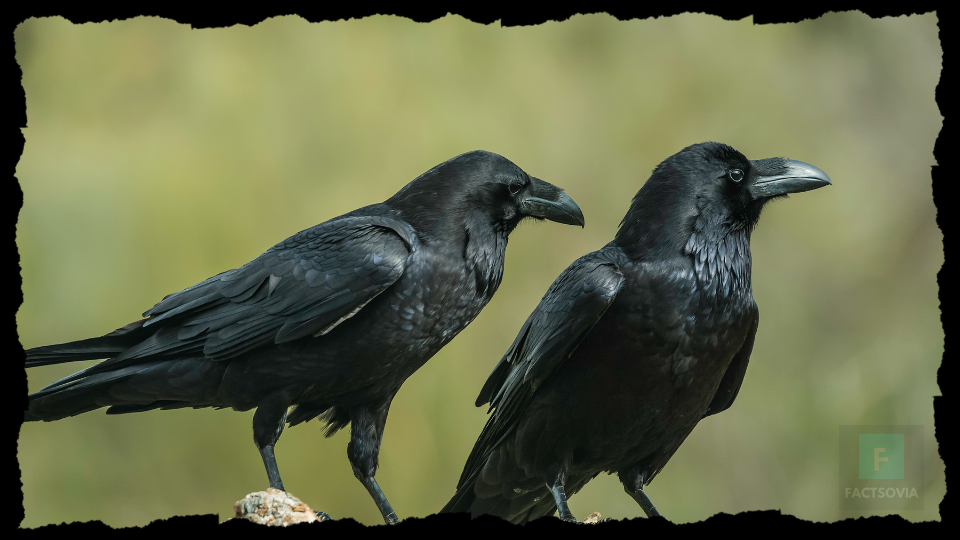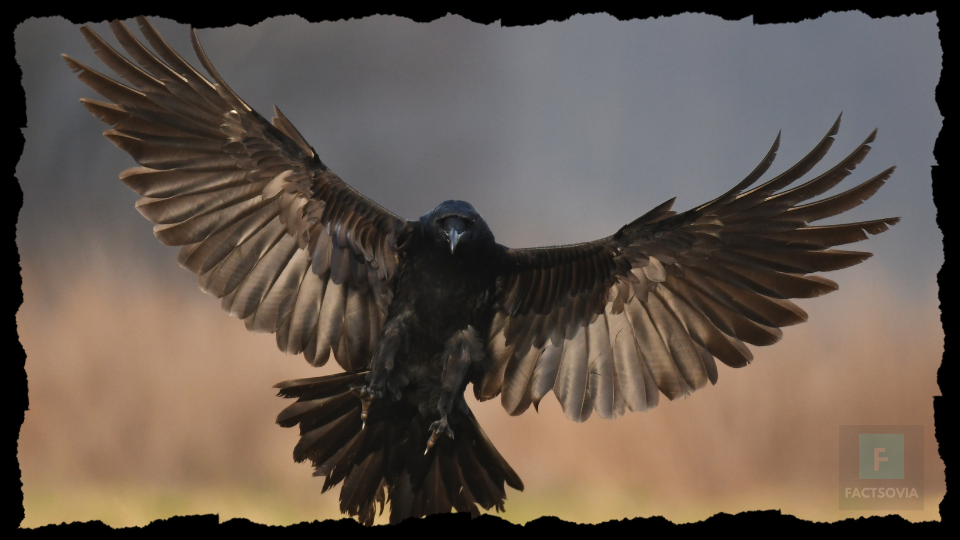We use affiliate links to run our site. When you buy through links on our site, we may earn an affiliate commission, without any added cost to you. Learn more
When it comes to avian intelligence and intrigue, few birds capture our fascination like ravens and crows. These black-feathered creatures have long been subjects of myth, symbolism, and scientific study.
While they may appear similar at first glance, ravens and crows are distinct species with unique characteristics and behaviors.
In this article, we’ll delve into the world of these remarkable birds, exploring their differences and shedding light on their captivating nature.
What are the Key Differences between a raven and a crow
To truly appreciate the contrast between ravens and crows, it’s important to first understand their physical characteristics and habitats.
Ravens (Corvus corax) are larger and heavier birds, measuring up to 26 inches in length, while crows (Corvus brachyrhynchos) are relatively smaller, averaging about 17 inches.
The raven’s wingspan is also wider, spanning up to 4.5 feet, compared to the crow’s average wingspan of 3 feet.
Another notable distinction lies in their voices. Ravens emit a deep, resonant croaking sound, often described as a throaty “gronk,” whereas crows produce a sharper, higher-pitched caw.
These vocalizations play a vital role in communication and establishing territory among these highly social birds.
Raven Vs Crow in a nutshell:
| Physical features | Raven | Crows |
| Size | Larger, up to 26 inches in length | Smaller, averaging about 17 inches |
| Wingspan | Wider, up to 4.5 feet | The average wingspan of 3 feet |
| Vocalization | Deep, resonant croaking sound | Sharp, higher-pitched caw |
| Social Behavior | Smaller groups or pairs | Larger flocks |
| Cultural Significance | Associated with wisdom and prophecy | Depicted as tricksters or shape-shifters |
| Conservation Status | Faces habitat loss and threats from urbanization and pesticide use | Requires conservation efforts for population protection |
Intelligence and Adaptability
Both ravens and crows display exceptional cognitive abilities, ranking among the most intelligent creatures on Earth. They exhibit problem-solving skills, tool use, and the capacity for complex social interactions. These traits have earned them a reputation as “feathered geniuses.”
Ravens, in particular, have been observed engaging in remarkable behaviors. They have demonstrated the ability to use tools to obtain food, navigate mazes, and even mimic human speech.
Crows, on the other hand, exhibit impressive problem-solving skills and have been observed using tools to extract food from hard-to-reach places. Their cleverness and adaptability enable them to thrive in various environments, including urban settings.
The Lazy Birdwatcher’s Way to Enjoy the Top 10 Purple Birds
Social Behavior and Communication

Both ravens and crows are highly social birds, forming intricate social structures within their communities. However, ravens tend to live in smaller groups or pairs, while crows form larger flocks. Ravens are known for their strong family bonds, and mated pairs often stay together for life.
Communication is a crucial aspect of their social behavior. Ravens and crows employ a wide range of vocalizations to convey messages to one another.
These vocal signals include calls that warn of danger, establish dominance hierarchies, and coordinate group activities.
They also communicate through body language, using various postures, wing displays, and head movements to express their intentions.
Cultural Significance and Folklore
Throughout history, ravens and crows have captivated the human imagination, featuring prominently in mythology, folklore, and literature across different cultures.
Their dark plumage and mysterious behaviors have often associated them with symbols of death, magic, and transformation.
In Norse mythology, ravens were believed to be the companions of Odin, the All-Father, and were associated with wisdom and prophecy.
In Native American folklore, the cleverness and adaptability of crows were admired, and they were often depicted as tricksters or shape-shifters.
Even in modern literature, these birds continue to inspire authors and artists, their enigmatic nature lending an air of mystique to their portrayal.
Conservation and Protection
Despite their intelligence and cultural significance, ravens and crows face various challenges in the modern world. Habitat loss, urbanization, and pesticide use pose threats to their populations.
However, recognizing the importance of these birds in maintaining ecosystem balance and the need for their conservation can help secure the future of crows and ravens, allowing these intelligent and remarkable birds to thrive and contribute to our natural world.

Frequently Asked Questions (FAQs):
Here are some of the most commonly asked questions about Ravens and crows.
Are ravens a type of crow?
No, ravens are not a type of crow. They are different, yet closely related, species of birds that belong to the same genus (Corvus) and family (Corvidae). Both are highly intelligent and have glossy black feathers, but ravens are larger and have thicker bills than crows.
Which is bigger, a raven or a crow?
Ravens are bigger than crows. Ravens can weigh almost twice as much as crows and have wingspans of around 45 inches. Crows have smaller wingspans and bodies around the size of pigeons.
Which is smarter, a crow or a raven?
Both crows and ravens are very smart, but some studies suggest that ravens may have a slight edge over crows in terms of cognitive abilities. Ravens can solve complex problems, use tools, mimic sounds, and communicate with each other in sophisticated ways.
Which are more common, ravens or crows?
In general, crows are more common than ravens. Crows have a broader distribution and can be found in many habitats worldwide, whereas ravens tend to prefer more remote and less populated areas. However, the abundance of each species can vary depending on the specific region.
Can crows and ravens mate?
Crows and ravens can mate, but they rarely do so in the wild. They are genetically compatible and can produce fertile offspring, but they have different behaviors and preferences that make them unlikely to interbreed.
However, there have been some reports of hybrid crows and ravens in captivity or in areas where their ranges overlap.
Are ravens afraid of crows?
Ravens are not afraid of crows, but they may avoid them if possible. Crows are more aggressive and territorial than ravens and will often mob or chase away ravens that enter their space. Ravens may retaliate or defend themselves if attacked, but they usually prefer to fly away from conflict.
Are crows more aggressive than ravens?
Crows are more aggressive than ravens in general. Crows will defend their nests, food sources, and territories from intruders, including other crows, ravens, hawks, owls, and humans.
They will also harass or attack predators that threaten their young or flock members. Ravens are less confrontational and more cautious around potential enemies.
Do crows hang out with ravens?
Crows and ravens do not hang out with each other by choice. They may coexist in the same area if there is enough food and space for both species, but they usually keep their distance from each other. Crows may try to drive away ravens that come too close to their resources or nests, while ravens may avoid areas with high crow activity.
Why do crows chase ravens?
Crows chase ravens because they see them as competitors or threats. Crows may perceive ravens as larger and stronger rivals that can steal their food or harm their young. Crows may also chase ravens to protect their territories or assert their dominance over them.
Do crows and ravens talk to each other?
Crows and ravens do not talk to each other in the sense of having a common language or understanding. However, they can communicate with each other through various sounds and gestures that convey information about their mood, intentions, or needs. Crows and ravens can also recognize and respond to each other’s calls or signals.
Conclusion:
As we come to the end of our exhilarating exploration of Raven vs Crows, we hope you’ve gained a newfound appreciation for these avian wonders. Their intelligence, adaptability, and intricate social structures have undoubtedly left an indelible impression.
Now, it’s your turn to spread the wings of knowledge. Share this post with your fellow bird enthusiasts, igniting their curiosity and sparking lively discussions.
Keep exploring our site for more captivating articles on nature’s marvels, as we continue to unravel the mysteries that lie beyond our doorsteps.
Remember, it’s through our collective efforts that we can preserve and protect the extraordinary creatures that share our world.
Amazon and the Amazon logo are trademarks of Amazon.com, Inc, or its affiliates.
